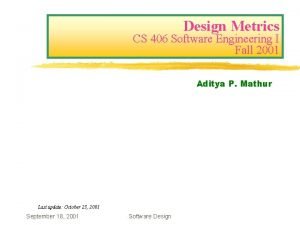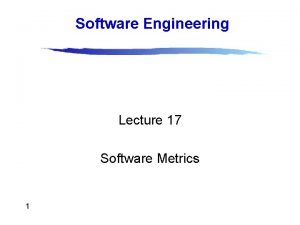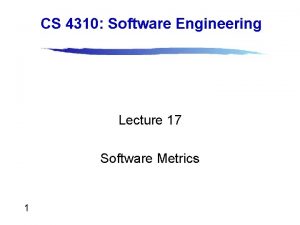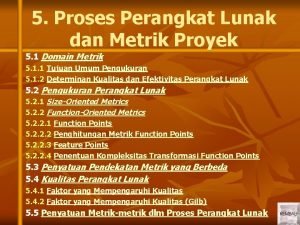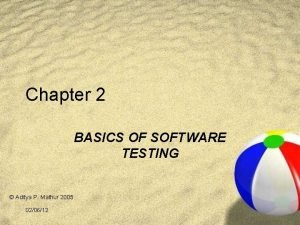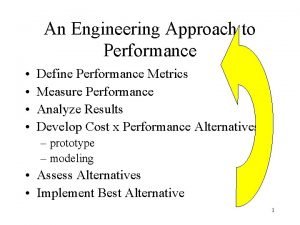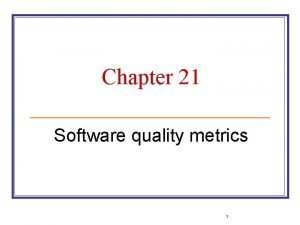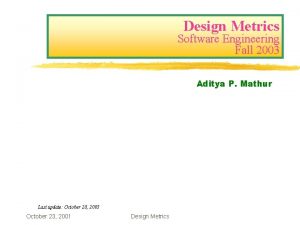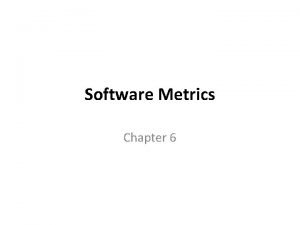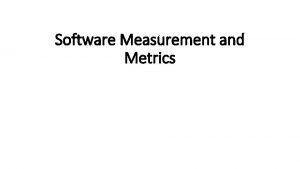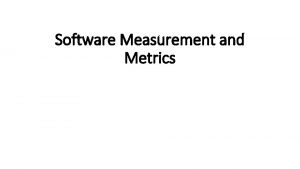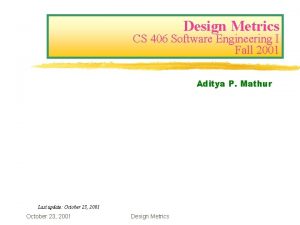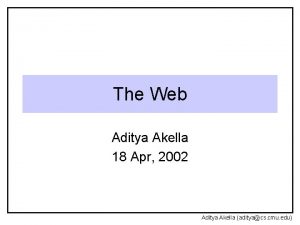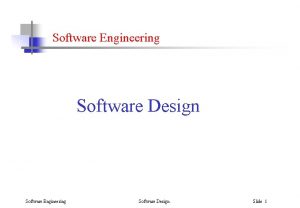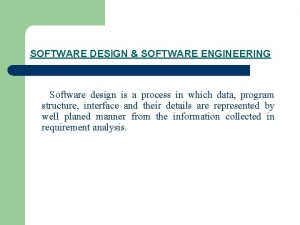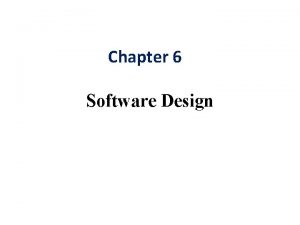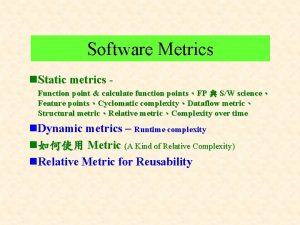Design Metrics Software Engineering Fall 2003 Aditya P













![Lack of cohesion in methods (LCOM) [1] z Let I 1 and I 2 Lack of cohesion in methods (LCOM) [1] z Let I 1 and I 2](https://slidetodoc.com/presentation_image_h/31670dccd2cdd58355c4640e52a1b563/image-14.jpg)

![LCOM [2] z A larger number of cohesive pairs implies smaller LCOM. z A LCOM [2] z A larger number of cohesive pairs implies smaller LCOM. z A](https://slidetodoc.com/presentation_image_h/31670dccd2cdd58355c4640e52a1b563/image-16.jpg)
![Guidelines for interpretation [1] Ref: http: //satc. gsfc. nasa. gov/support/STC_APR 98/apply_oo. html METRIC OBJECTIVE Guidelines for interpretation [1] Ref: http: //satc. gsfc. nasa. gov/support/STC_APR 98/apply_oo. html METRIC OBJECTIVE](https://slidetodoc.com/presentation_image_h/31670dccd2cdd58355c4640e52a1b563/image-17.jpg)
![Guidelines for interpretation [2] METRIC OBJECTIVE Lack of Cohesion of Methods/ Low/ High Coupling Guidelines for interpretation [2] METRIC OBJECTIVE Lack of Cohesion of Methods/ Low/ High Coupling](https://slidetodoc.com/presentation_image_h/31670dccd2cdd58355c4640e52a1b563/image-18.jpg)
![Guidelines for interpretation [3] October 23, 2001 Design Metrics 19 Guidelines for interpretation [3] October 23, 2001 Design Metrics 19](https://slidetodoc.com/presentation_image_h/31670dccd2cdd58355c4640e52a1b563/image-19.jpg)
![Guidelines for interpretation [4] October 23, 2001 Design Metrics 20 Guidelines for interpretation [4] October 23, 2001 Design Metrics 20](https://slidetodoc.com/presentation_image_h/31670dccd2cdd58355c4640e52a1b563/image-20.jpg)
![Guidelines for interpretation [5] Almost 66% of this project’s classes are below other classes Guidelines for interpretation [5] Almost 66% of this project’s classes are below other classes](https://slidetodoc.com/presentation_image_h/31670dccd2cdd58355c4640e52a1b563/image-21.jpg)

- Slides: 22

Design Metrics Software Engineering Fall 2003 Aditya P. Mathur Last update: October 28, 2003 October 23, 2001 Design Metrics

Design Metrics z Design Metrics are useful in measuring the complexity and “goodness” of a design. z A large number metrics have been proposed for OO designs. z Some of these have been validated experimentally, others are mere proposals or have received little or no validation. October 23, 2001 Design Metrics 2

Effort z Assumption: The effort in developing a class is determined by the number of methods. z Hence the overall complexity of a class can be measured as a function of the complexity of its methods. Proposal: Weighted Methods per class (WMC) October 23, 2001 Design Metrics 3

WMC z Let class C have methods M 1, M 2, . . . Mn. z. Let denote the complexity of method z How to measure WMC? October 23, 2001 Design Metrics 4

WMC: validation z Most classes tend to have a small number of methods, are simple, and provide some specific abstraction and operations. z WMC metric has a reasonable correlation with fault-proneness of a class. October 23, 2001 Design Metrics 5

Depth of inheritance tree (DIT) z Depth of a class in a class hierarchy determines potential for re-use as more methods are available. Deeper classes have higher potential for re-use though are more complex. z Inheritance increases coupling. Changing classes becomes harder. z Depth of Inheritance (DIT) of class C is the length of the shortest path from the root of the inheritance tree to C. z In the case of multiple inheritance DIT is the maximum length of the path from the root to C. October 23, 2001 Design Metrics 6

DIT evaluation z Basili et al. study, 1995. z Chidamber and Kemerer study, 1994. • • October 23, 2001 Most classes tend to be close to the root. Maximum DIT value found to be 10. Most classes have DIT=0. DIT is significant in predicting error proneness of a class. Higher DIT leads to higher error-proneness. Design Metrics 7

Number of children (NOC) z NOC is the number of immediate subclasses of C. z Higher values of NOC suggest reuse of the definitions in the super-class in a larger number of subclasses. z Higher NOC suggests the extent of influence of a class on other elements of a design. Higher influence demands higher quality of that class. October 23, 2001 Design Metrics 8

Validation of NOC z Classes generally have a small NOC value. z Vast majority have NOC=0. z Larger NOC value is associated with lower probability of detecting faults in that class. October 23, 2001 Design Metrics 9

Coupling between classes (CBC) z Class C 1 is coupled to class C 2 if at least one method of C 1 uses a method or an instance variable of C 2. z Coupling is usually easy to identify though often pointers may make it difficult. z CBC of C=total number of other classes to which C is coupled. October 23, 2001 Design Metrics 10

Validation of CBC z Most classes are self contained and have CBC=0. z Interface classes tend to have higher CBC values. z CBC is significant in predicting fault-proneness of classes. October 23, 2001 Design Metrics 11

Response for a class (RFC) z Response set of class C is the total number of methods that can be invoked when a message is sent to an object of C. y This includes all methods of C and any methods executed outside of C as a result of this message. z RFC of class C is the cardinality of the response set of C. z Note that even when CBC=1 RFC may be high. This indicates that the “volume” of interaction is high. October 23, 2001 Design Metrics 12

Validation of RFC z Most classes tend to invoke a small number of methods (low RFC values). z Classes for interface objects tend to have larger RFC values. z RFC is very significant in predicting the fault-proneness of a class. October 23, 2001 Design Metrics 13
![Lack of cohesion in methods LCOM 1 z Let I 1 and I 2 Lack of cohesion in methods (LCOM) [1] z Let I 1 and I 2](https://slidetodoc.com/presentation_image_h/31670dccd2cdd58355c4640e52a1b563/image-14.jpg)
Lack of cohesion in methods (LCOM) [1] z Let I 1 and I 2 denote sets of instance variables accessed by methods M 1 and M 2, respectively, in class C. z M 1 and M 2 are considered similar, or cohesive, if I 1 and I 2 are not disjoint. z Let Q be the set of all cohesive method pairs. z Let P be the set of all non-cohesive method pairs. z LCOM=|P| - |Q| if |P| > |Q|, 0 otherwise. October 23, 2001 Design Metrics 14

October 23, 2001 Design Metrics 15
![LCOM 2 z A larger number of cohesive pairs implies smaller LCOM z A LCOM [2] z A larger number of cohesive pairs implies smaller LCOM. z A](https://slidetodoc.com/presentation_image_h/31670dccd2cdd58355c4640e52a1b563/image-16.jpg)
LCOM [2] z A larger number of cohesive pairs implies smaller LCOM. z A high value of LCOM suggests that a class is trying to support multiple abstractions. Perhaps the class needs to be partitioned into smaller and more cohesive classes. z LCOM is not found to be very significant in predicting fault-proneness. October 23, 2001 Design Metrics 16
![Guidelines for interpretation 1 Ref http satc gsfc nasa govsupportSTCAPR 98applyoo html METRIC OBJECTIVE Guidelines for interpretation [1] Ref: http: //satc. gsfc. nasa. gov/support/STC_APR 98/apply_oo. html METRIC OBJECTIVE](https://slidetodoc.com/presentation_image_h/31670dccd2cdd58355c4640e52a1b563/image-17.jpg)
Guidelines for interpretation [1] Ref: http: //satc. gsfc. nasa. gov/support/STC_APR 98/apply_oo. html METRIC OBJECTIVE Cyclomatic Complexity Low Lines of Code/Executable Statements Low Comment Percentage ~ 20 – 30 % Weighted Methods per Class Low Response for a Class Low October 23, 2001 Design Metrics 17
![Guidelines for interpretation 2 METRIC OBJECTIVE Lack of Cohesion of Methods Low High Coupling Guidelines for interpretation [2] METRIC OBJECTIVE Lack of Cohesion of Methods/ Low/ High Coupling](https://slidetodoc.com/presentation_image_h/31670dccd2cdd58355c4640e52a1b563/image-18.jpg)
Guidelines for interpretation [2] METRIC OBJECTIVE Lack of Cohesion of Methods/ Low/ High Coupling Between Objects Low Depth of Inheritance Low (trade-off) Number of Children Low (trade-off) October 23, 2001 Design Metrics 18
![Guidelines for interpretation 3 October 23 2001 Design Metrics 19 Guidelines for interpretation [3] October 23, 2001 Design Metrics 19](https://slidetodoc.com/presentation_image_h/31670dccd2cdd58355c4640e52a1b563/image-19.jpg)
Guidelines for interpretation [3] October 23, 2001 Design Metrics 19
![Guidelines for interpretation 4 October 23 2001 Design Metrics 20 Guidelines for interpretation [4] October 23, 2001 Design Metrics 20](https://slidetodoc.com/presentation_image_h/31670dccd2cdd58355c4640e52a1b563/image-20.jpg)
Guidelines for interpretation [4] October 23, 2001 Design Metrics 20
![Guidelines for interpretation 5 Almost 66 of this projects classes are below other classes Guidelines for interpretation [5] Almost 66% of this project’s classes are below other classes](https://slidetodoc.com/presentation_image_h/31670dccd2cdd58355c4640e52a1b563/image-21.jpg)
Guidelines for interpretation [5] Almost 66% of this project’s classes are below other classes in the tree, which indicates a moderate level of reuse. Higher percentages for DIT’s of 2 and 3 would show a higher degree of reuse, but increased complexity. October 23, 2001 Design Metrics 21

Summary of OO metrics Ref: http: //satc. gsfc. nasa. gov/support/STC_APR 98/apply_oo. html SOURCE METRIC Traditional Cyclomatic complexity (CC) Lines of Code (LOC) Comment percentage (CP) NEW NEW NEW Weighted methods per class Class/Method Response for a class (RFC) Class/Message Lack of cohesion of methods (LCOM) Class/Cohesion Coupling between objects (CBC) Coupling Depth of inheritance tree (DIT) Inheritance Number of children (NOC) Inheritance October 23, 2001 Design Metrics OO CONSTRUCT Method 22
 Metrics computer science
Metrics computer science Halstead software metrics example
Halstead software metrics example Design metrics in software engineering
Design metrics in software engineering Weighted methods per class
Weighted methods per class Data structure metrics in software engineering
Data structure metrics in software engineering Process and project metrics in software engineering
Process and project metrics in software engineering Function point metrics in software engineering
Function point metrics in software engineering Function point metrics in software engineering
Function point metrics in software engineering Software process and project metrics
Software process and project metrics Domain pengukuran software
Domain pengukuran software Quality metrics in software engineering
Quality metrics in software engineering Foundations of software testing aditya p mathur pdf
Foundations of software testing aditya p mathur pdf Real time software design in software engineering
Real time software design in software engineering Software design fundamentals in software engineering
Software design fundamentals in software engineering Kim ki duk spring summer fall winter
Kim ki duk spring summer fall winter Engineering performance metrics
Engineering performance metrics Engineering performance metrics
Engineering performance metrics Engineering performance metrics
Engineering performance metrics Computer based system engineering
Computer based system engineering Forward engineering and reverse engineering
Forward engineering and reverse engineering Defect arrival pattern
Defect arrival pattern Software productivity metrics formula
Software productivity metrics formula Software metrics tool
Software metrics tool


